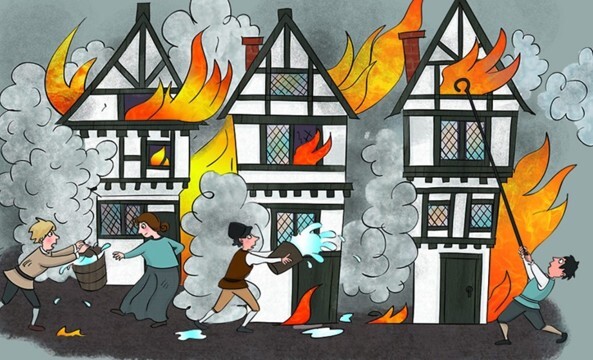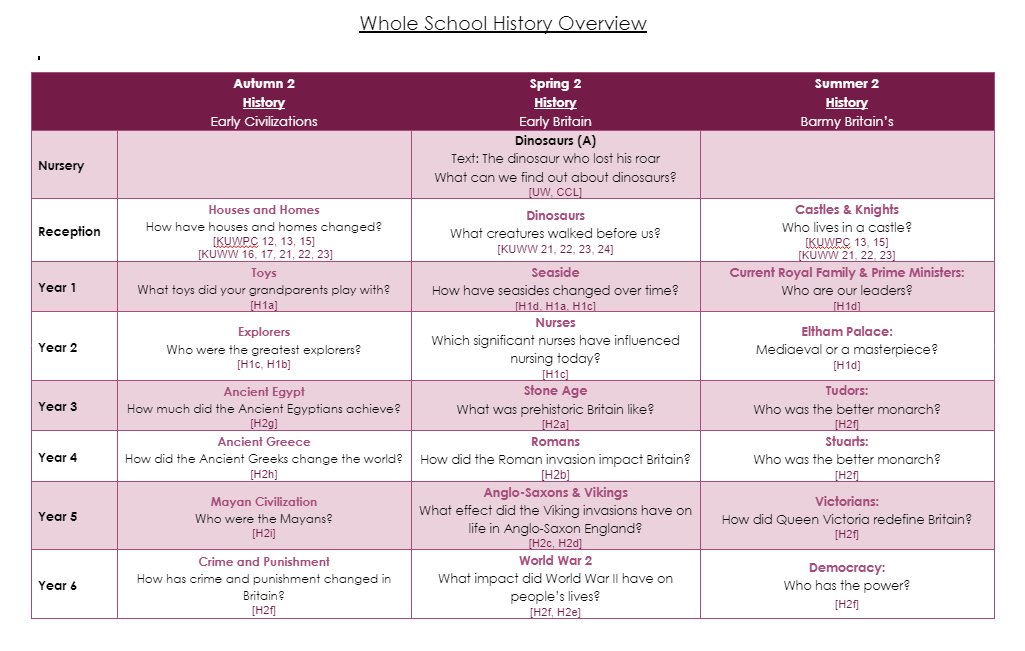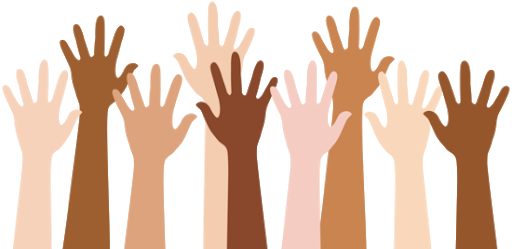History

In the National Curriculum, the first purpose of History is listed as to ‘help pupils gain a coherent knowledge and understanding of Britain’s past and that of the wider world’. At Gray’s farm, we believe this is only the tip of the iceberg of the reasons why we teach History. For us, its true value lies in teaching children about different ways of life, igniting their curiosity as they discover things that fascinate them; learning how to think critically and question what a piece of evidence is trying to tell them; understanding how history is woven together globally and that our history includes people of all abilities, races, social classes and genders.
Our History curriculum interlinks knowledge, concepts, representation and skills. The knowledge is the information children learn and recall; concepts are the bigger themes in history (such as chronology, similarity and difference, and causes and effect); and the skills are what children do to find out and show the information they have learnt (questioning, deducing, analysing, writing etc.)
EYFS
In the Early Years Foundation Stage, children learn History through ‘Understanding the World’. Their activities are very practical and play-based. They have the opportunity to explore artefacts from the past and use these to develop their abilities to make observations, question and draw conclusions.
KS1 and KS2
In KS1, children are required to cover broad topics, such as change within and beyond living memory, and significant events and individuals. Our curriculum focuses on events which are insightful and fun, and includes people who we believe have had a significant impact on our country and the wider world. Representation is always important to us when choosing significant individuals to explore in our history lessons; ensuring men, women, different ethnicities, religions and disabilities are included; allowing our children to appreciate and celebrate differences in cultures, beliefs and backgrounds.
In KS2, we have designed our curriculum so that a chronological timeline is established throughout the school year and also as the children progress through the school to further support our children and their understanding of chronology. We cover periods of history that include the earliest people and civilisations in the world to modern day events.
Our history curriculum is progressive; building on skills and knowledge throughout the year and as the children move up through the school; enabling our children to make connections and build upon their previous learning. To facilitate this progression, our history curriculum has been grouped into three overarching units:
-
Early Civilizations in the Autumn Term
-
Early Britain in the Spring Term
-
Barmy Britain in the Summer Term
An overview detailing our history coverage for each year group from Nursery to Year 6 can be found here.

Each topic has a key question that the children will attempt to answer throughout the term using a range of historical sources. Low-stake quizzes are completed by all children at the beginning and end of a topic to monitor progress, along with a rigorous monitoring cycle involving pupil voice, work scrutinies and monitoring of the learning environment across all year groups to inform future planning.
Black History Month

October is Black History Month but here at Gray’s, we don’t want to restrict it to just one month. As such, we have been working hard to redesign and develop our wider curriculum. Our aim is to create a curriculum that prepares our children for life beyond Gray’s Farm and the classroom; a curriculum that gives them opportunities to be excited about learning and develop enquiring minds whilst giving them access to lessons that celebrate diversity and promote acceptance. We want a curriculum that allows our children to regularly learn about, and be inspired by, individuals from all backgrounds, cultures, religions and ethnicities. It is really important for us as a school, that the celebration of different cultures is embedded in our lessons and discussed frequently at every opportunity possible throughout the year and not just throughout the month of October. Weaving diversity throughout our curriculum is an on-going project and something we all feel incredibly passionate about.
We want to focus on how the persistence and determination of significant individuals, from all backgrounds, have positively influenced the world in which we live and celebrate their achievements and contributions. We have considered how we can represent different cultures in all of our subjects, from Art to PE. Year 5’s current science topic on Space is a recent example of how we have enhanced our curriculum to celebrate the impact different females had on developments in space. These have included learning about the first woman to travel in space – a Russian lady called Valentina Tereshkova, and how three female African-American mathematicians (Katherine Jonson, Mary Jackson and Dorothy Vaughan) played a fundamental role in launching the first man into orbit.
SEND - Ambition and Access in Geography / History
|
Ambition – What are we aiming for children with SENs to achieve in this subject? |
Access – What amendments are made to the subject in order to help children with SENs to achieve? |
|
We need to be ambitious about what our children with SEN can achieve and not believe their ability is ‘fixed’ for every subject. Yes, we should take into consideration their barriers to learning but we shouldn't let these limit their opportunities - just because they find reading difficult, it doesn't mean that they won’t be able to interpret Ancient Egyptian hieroglyphics or read a map. |
|
|
|